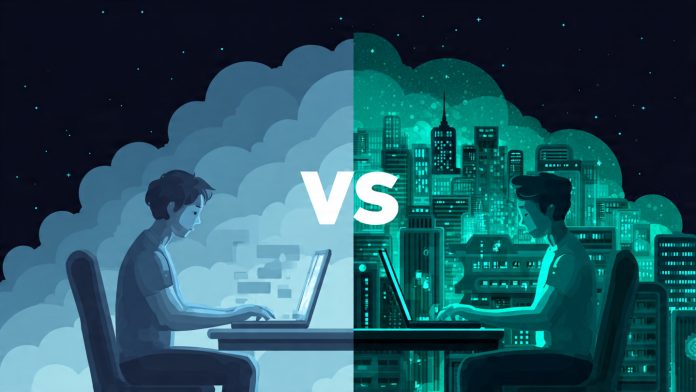The Decentralization Dilemma – When you are working remotely—logging into client systems, processing sensitive FinTech data, or running AI-powered applications—where is your data safest?
For years, the answer was simple: The Cloud (AWS, Azure, Google Cloud). Centralized, robustly protected, and scalable. But today, the digital nomad lifestyle demands speed (low latency) and autonomy. This is where Edge Computing steps in, processing data closer to you, on your devices (or nearby mini-servers).
As a Cyber Security Architect, I see a constant tug-of-war between the convenience of the Cloud and the low-latency power of the Edge. The critical question is: Which architecture offers superior security for a mobile, distributed business?
Let’s break down the security models of Cloud vs. Edge so you can make an informed decision for your remote work setup in 2025.
The Cloud Security Model (Centralized Fortress)
Cloud Computing is like a massive, centrally guarded bank vault:
- Strength: Depth of Defense: Cloud providers (AWS, Azure) employ thousands of security experts and offer layers of defense (physical security, encryption, massive DDoS protection).
- Weakness: Single Point of Failure (SPOF) Risk: A breach at the central data center could expose millions of users (though rare).
- Key Challenge for Nomads: The “Last Mile” Problem: Your data is secure in the cloud, but the connection from your temporary coffee shop Wi-Fi (the “last mile”) to the cloud remains a high-risk vector.
The Edge Computing Model (Distributed Defense)
Edge Computing is about decentralizing processing to the source (your laptop, IoT device, or local gateway).
- Strength: Isolation and Performance: Data is processed locally and immediately, leading to near-zero latency. A breach on one Edge device (your laptop) does not necessarily compromise the entire network.
- Weakness: Physical Security Risk: Edge devices are often physically exposed (e.g., in a hotel, airport). If your portable WiFi hotspot (as discussed in the Travel Tech post) or laptop is stolen, the data on the Edge device is at risk.
- Key Challenge for Nomads: Consistency: Maintaining consistent security patching, updates, and compliance across dozens of distributed Edge devices is a management nightmare.
A Head-to-Head Comparison for the Remote Professional
| Security Factor | Cloud Security | Edge Security | Nomad Verdict |
| Data Breach Surface | Centralized, Large Target | Distributed, Many Small Targets | Edge (Lower risk of mass exposure) |
| Physical Security | Extremely High (Secured Data Centers) | Low (Dependent on the user/device) | Cloud (Far Superior) |
| Latency/Speed | High Latency for Far-Flung Users | Near-Zero Latency (Instant Processing) | Edge (Better for real-time applications) |
| Management Overhead | Low (Handled by Provider) | High (Requires managing all Edge devices) | Cloud (Simpler to maintain) |
Strategic Recommendation:
For highly sensitive, regulated data (like client financial records), keep the storage and final processing in the Cloud. Use Edge Computing only for real-time filtering, aggregation, and immediate operational tasks that require low latency. The best strategy is always a Hybrid Architecture.
Implementing Hybrid Security Strategies (The Best of Both Worlds)
A hybrid approach is the only sustainable solution for digital nomads:
- Zero Trust Architecture (ZTA): Assume every device (especially Edge devices) and every network is hostile. Verify every connection and user identity, regardless of location.
- Encryption at the Edge: Encrypt all data before it leaves your local Edge device, even if it’s going to a secure Cloud.
- Secure Hotspot Use: As previously discussed, ensure your portable WiFi hotspot utilizes WPA3 and is combined with a strong VPN to secure the “last mile” connection to the Cloud.
Conclusion: Security is a Strategy, Not a Location
The safest architecture for a digital nomad isn’t inherently the Cloud or the Edge—it’s the one you manage correctly.
By adopting a Hybrid ZTA model and diligently applying security protocols to your Edge devices, you can achieve both the high performance of Edge and the robust data integrity of the Cloud. Don’t chase trends; chase security excellence.
(Call to Action): Securing your architecture is one thing, but how do you secure your finances? Read our latest guide on leaving risky traditional banks behind: “Why You Don’t Need a Traditional Business Bank Account in the FinTech Era (2025)“


